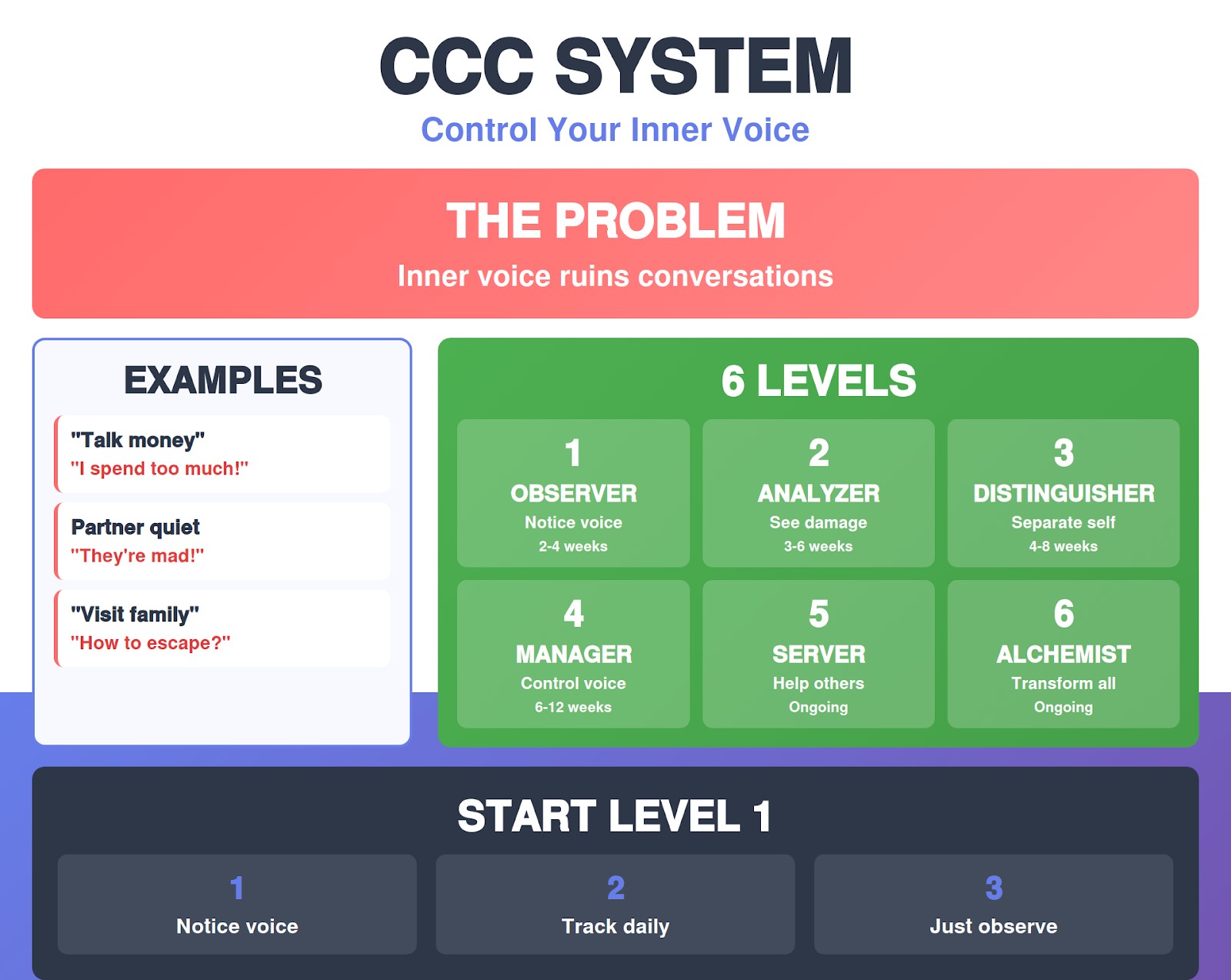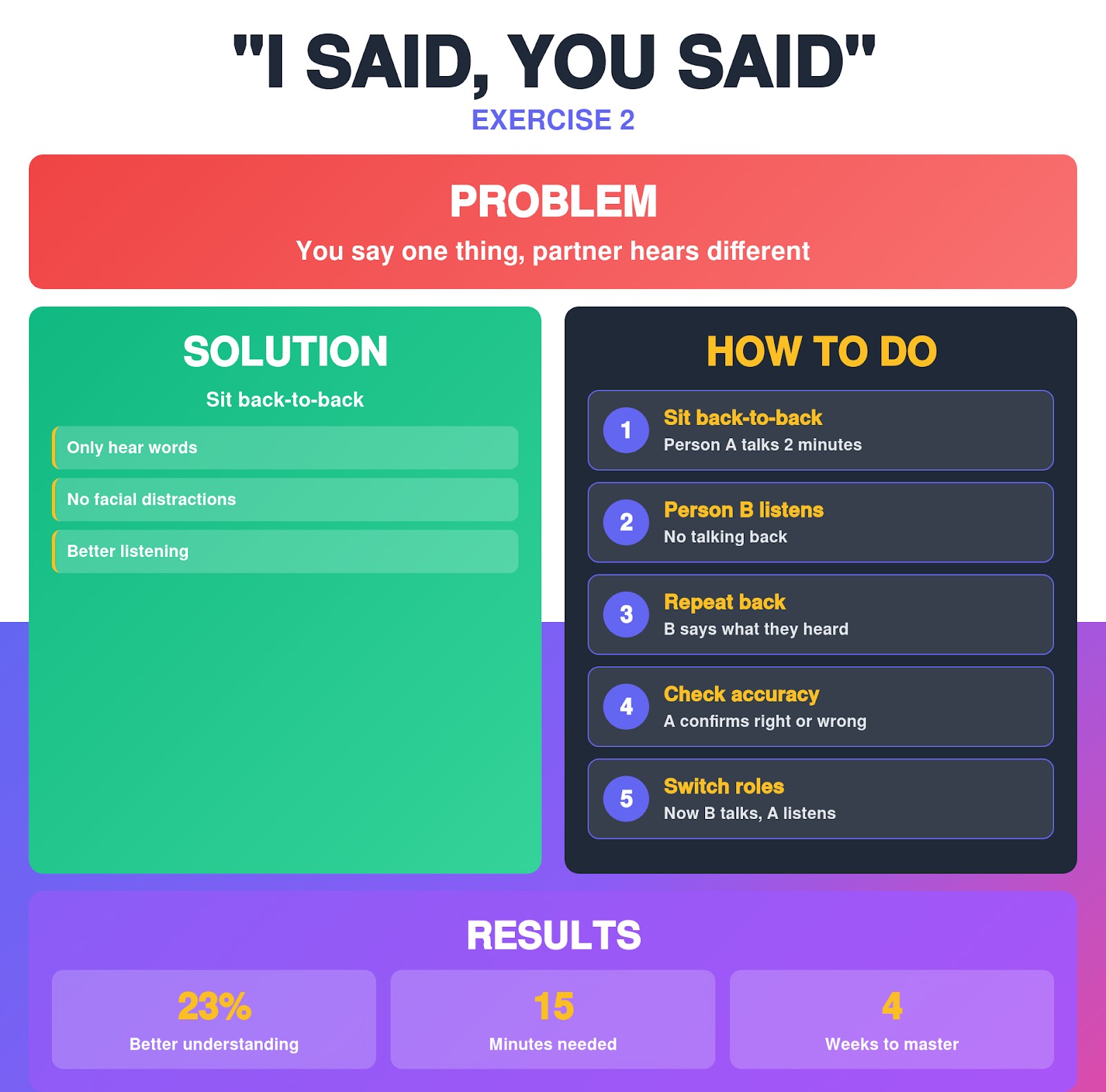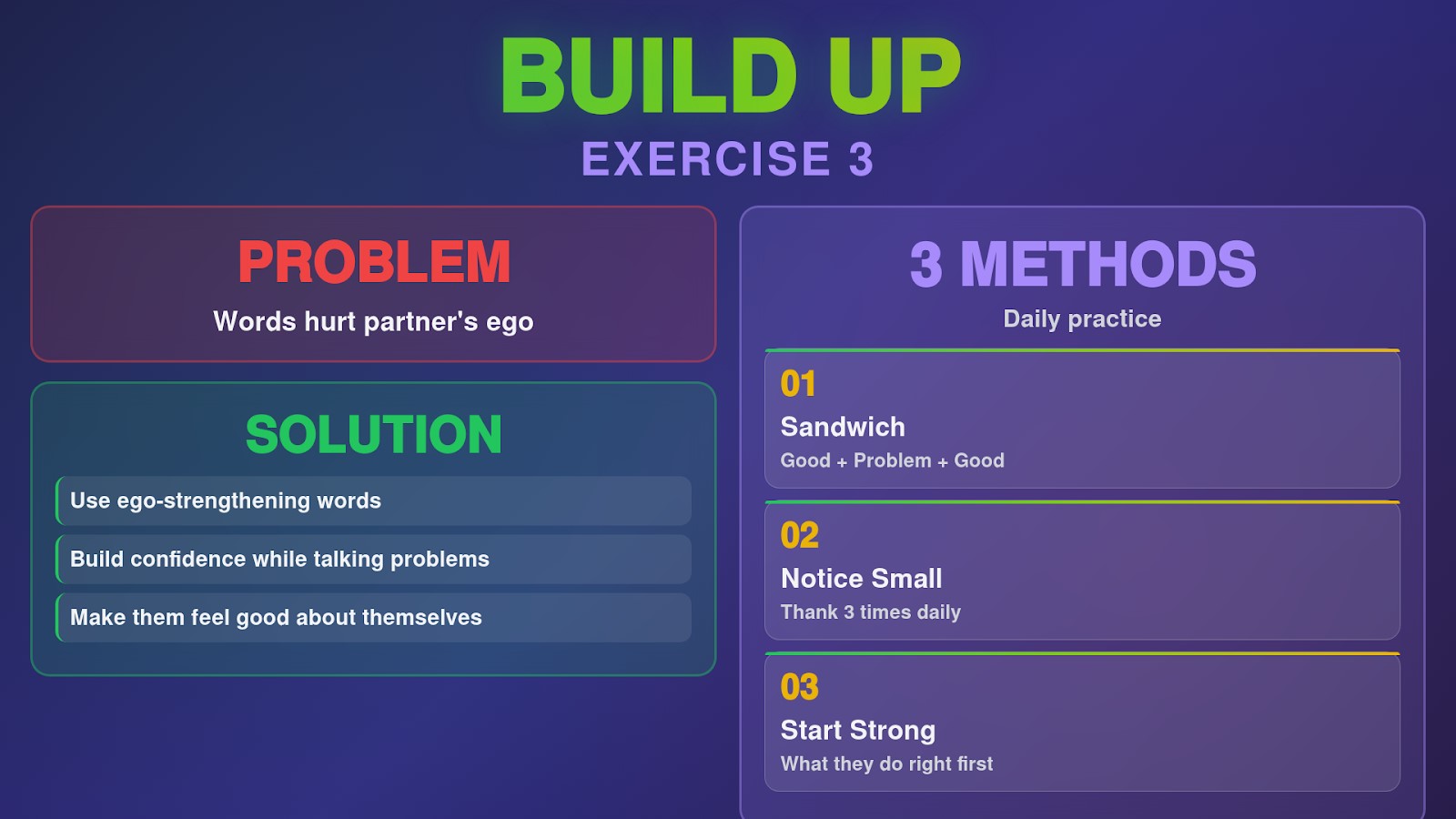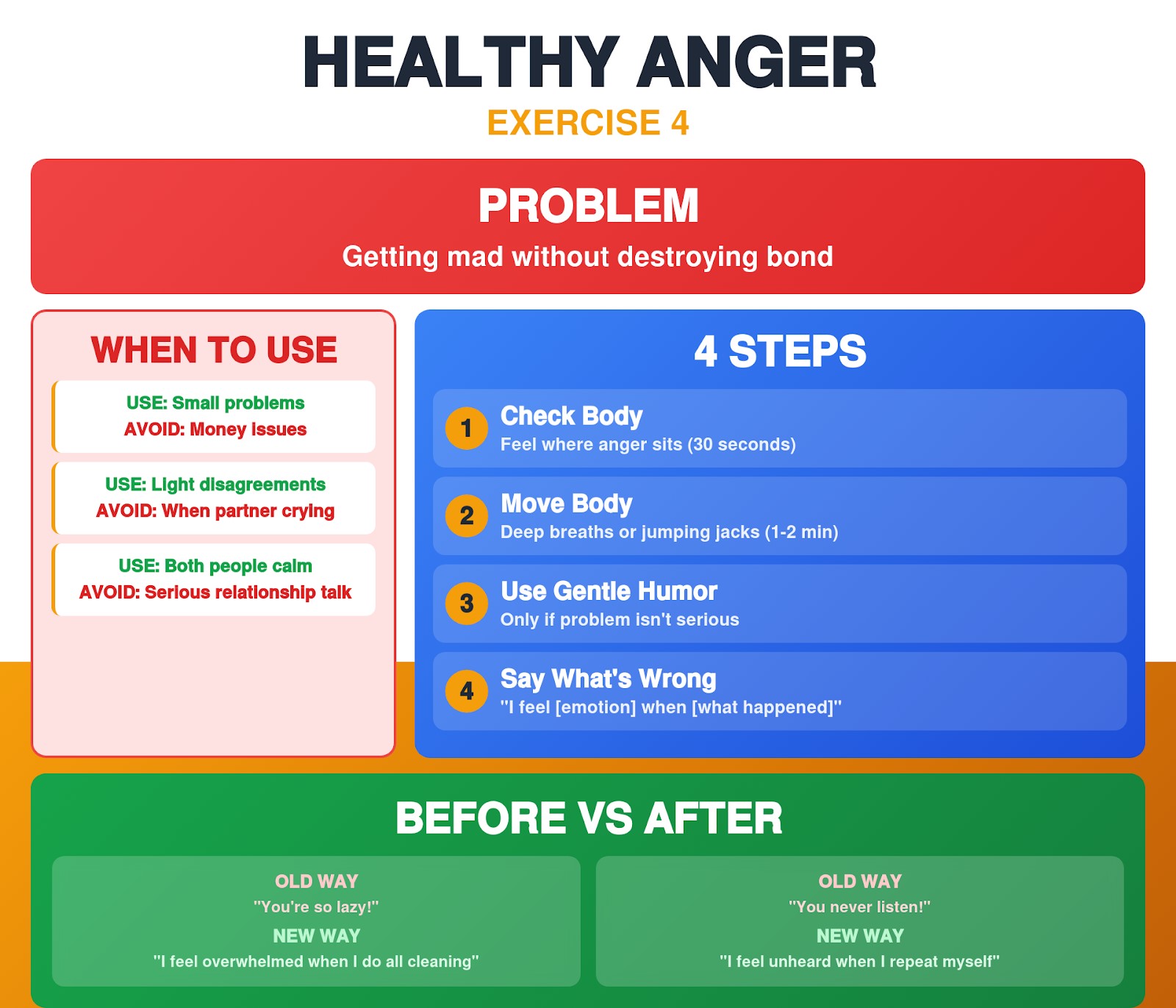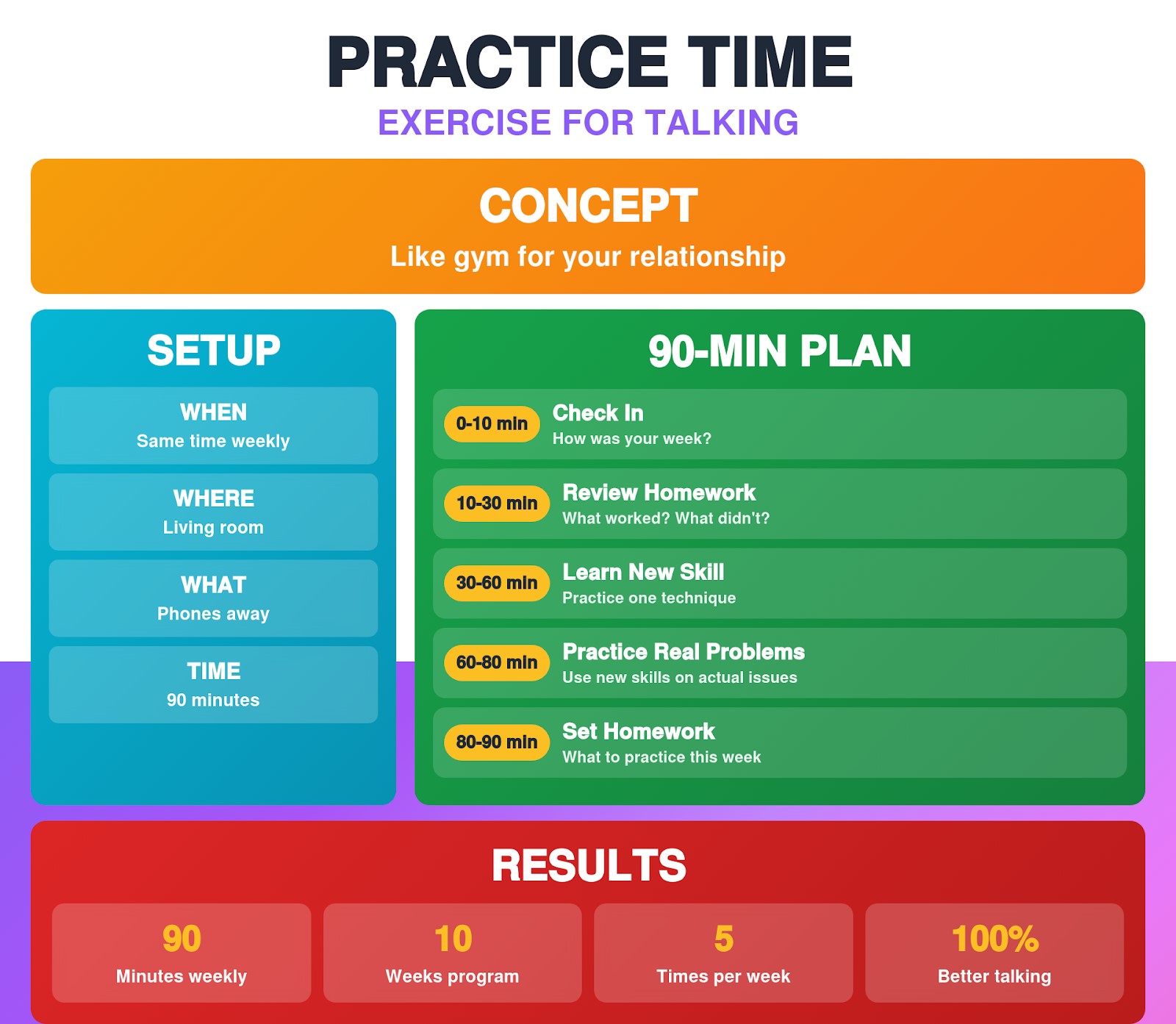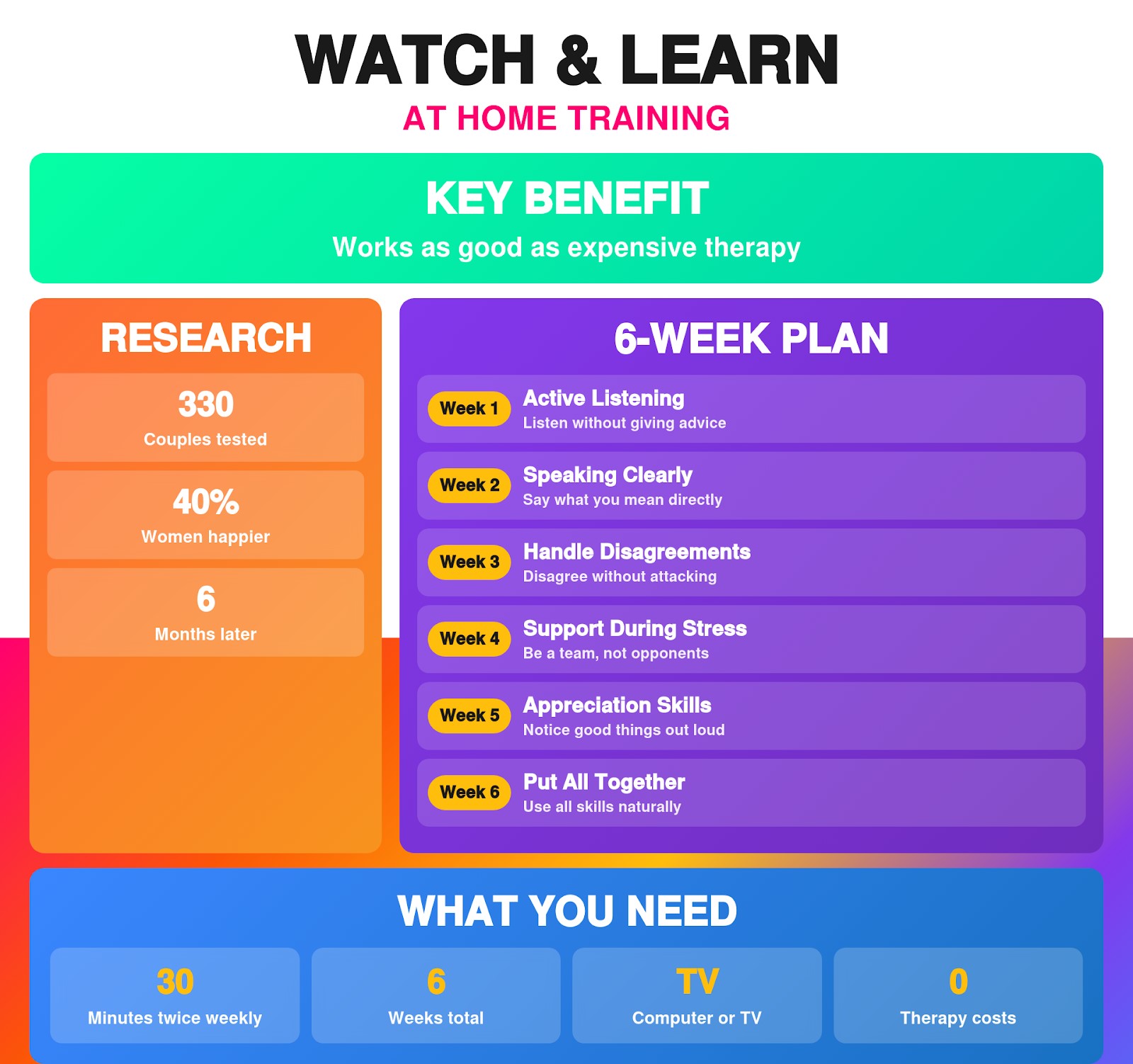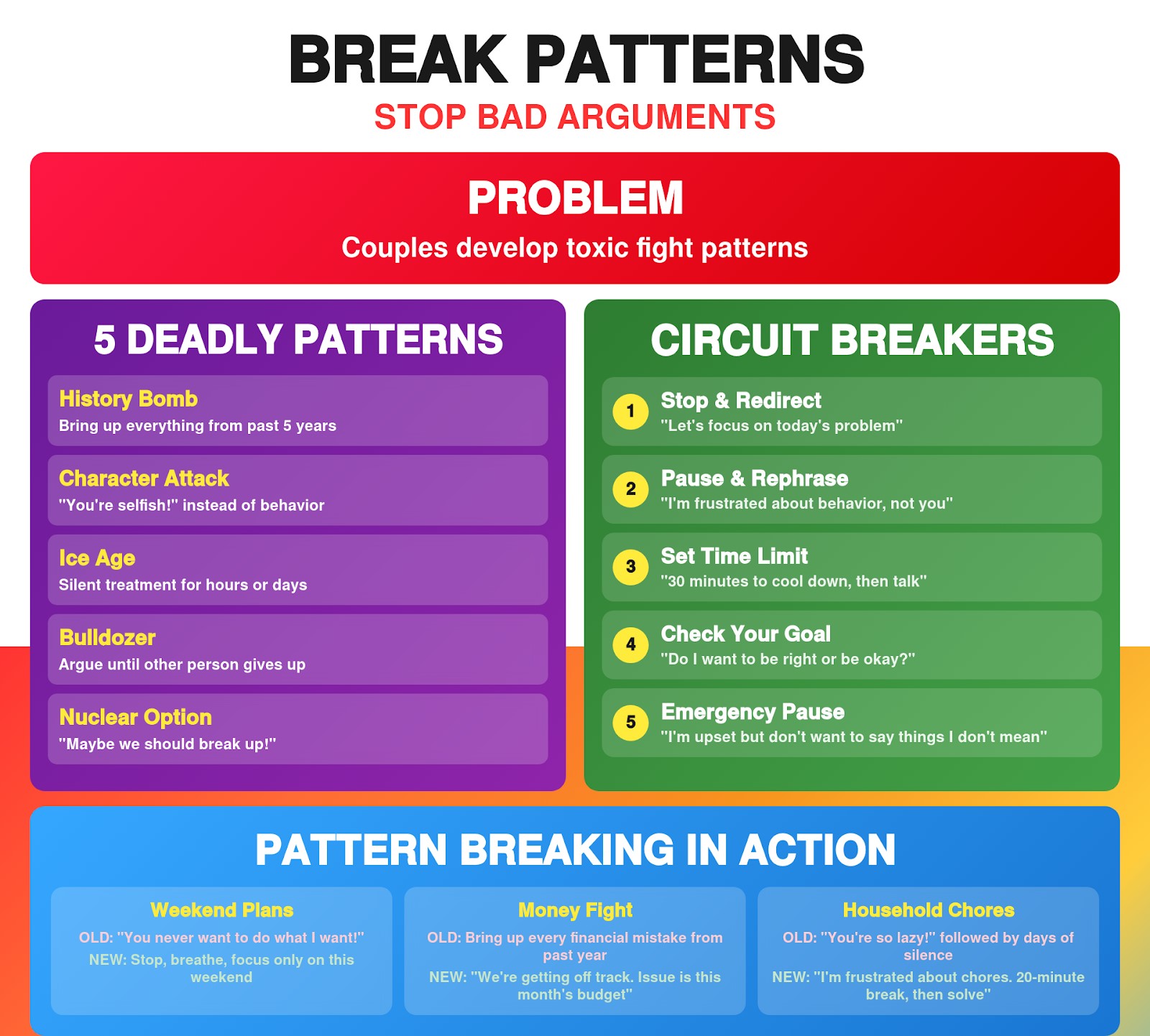You and your partner are at dinner together, but you still feel like you don’t know each other.
People ask you easy questions like “How was your day?” and you both get mad for no clear reason.
At the same time, that voice in your head keeps judging everything they do, which makes you angry before they even finish talking. It’s killing marriages one talk at a time, and it happens to every couple.
But some communication activities might quickly improve this.
- Watch and Learn at Home
- Break Your Worst Argument Patterns
- Build Each Other Up Daily
- Control Your Inner Voice
Exercises 1: Use The CCC Training System (Convert Confusion to Clarity)
Have that voice in your head that talks all the time? The one that says, “This relationship won’t work out” or “Your partner doesn’t really love you”?
It’s what Hooman Motevalli calls your “Roommate,” and it’s probably making your relationship worse without you even realizing it. If you want a deeper dive into how this inner voice operates and how to train it, check out Don’t Be a Crab, where he breaks it down step by step.
He found that the steady talk in our heads makes us confused, leads us to make bad choices, and hurts our relationships.
Why Your Inner Voice Ruins Conversations?
Example 1: Your partner tells you, “Let’s talk about money.”
- Right away, your inner voice tells you, “Oh no, they think I spend too much.” I need to stand up for myself.”
- There’s a defense response before you even hear what they want to talk about.
Example 2: Your partner is quiet after work
- A voice inside you says, “They’re mad at me.” “What did I do wrong?”
- You start to feel worried and keep asking, “Are you okay?” instead of just being there.
Example 3: Your partner wants to go to their family’s house.
- Your inner voice says, “I hate going there.” What’s the way out?”
- You start making excuses immediately before you even think about what they might really care about.
The 6-Level Training System
Motevalli’s program has 6 levels that build on each other. You don’t move to the next level until you master the current one.
| Level | Name | What You Learn | Time to Master |
|---|---|---|---|
| 1 | The Observer | Notice the voice in your head | 2–4 weeks |
| 2 | The Analyzer | Understand how it affects your relationships | 3–6 weeks |
| 3 | The Distinguisher | Separate yourself from the voice | 4–8 weeks |
| 4 | The Manager | Control the voice instead of it controlling you | 6–12 weeks |
| 5 | The Server | Help your partner and others | Ongoing |
| 6 | The Alchemist | Transform your relationship completely | Ongoing |
Level 1: Become an Observer (Start Here)
What to do: For one week, just notice when your inner voice starts talking during conversations with your partner.
How to practice:
- Carry a small notebook
- Every time you catch your inner voice commenting during a conversation, write it down
- Don’t try to stop it yet, just notice it
Daily tracking sheet:
| Time | What Partner Said | What Inner Voice Said | How I Responded |
|---|---|---|---|
| 7am | “Good morning.” | “They sound grumpy.” | Asked if they were okay |
| 6pm | “How was work?” | “They don’t really care.” | Gave a short answer |
| 9pm | “Want to watch TV?” | “They always pick boring shows.” | Said, “Whatever you want.” |
Level 2: Analyze the Damage
What to do: After one week of observing, look at how your inner voice affects your relationship.
3 categories to track:
- Relationship damage: Times your inner voice made you respond poorly to your partner
- Reputation damage: Times it made you look bad or defensive
- Mental health damage: Times it made you feel anxious, angry, or sad for no real reason
Weekly analysis questions:
- How many times did my inner voice make me defensive when my partner wasn’t attacking me?
- How often did it make me assume the worst about my partner’s intentions?
- When did it stop me from really listening to what my partner was saying?
Level 3: Separate Yourself from the Voice
What to do: Start treating your inner voice like a separate person who gives you advice (usually bad advice).
Practice technique: When your inner voice says something during a conversation, mentally respond to it like this:
- Inner voice: “They’re criticizing you!”
- You to inner voice: “Thanks for the warning, but I’m going to listen to what they’re actually saying first.”
Level 4: Manage Your Inner Voice
What to do: Take control of conversations by managing your internal reactions.
The 3-step management process:
- Pause: When your partner is talking, notice if your inner voice starts responding
- Acknowledge: Mentally say, “I hear you, inner voice, but you’re not in charge right now.”
- Respond: Answer based on what your partner actually said, not your inner voice’s interpretation
Real Conversation Examples
Situation 1: Partner says, “You’ve been on your phone a lot lately.”
- Inner voice response: “They’re trying to control me! I work hard; I deserve phone time!”
- Managed response: “You’re right, I have been. Is it bothering you? What would help?”
Situation 2: Partner suggests couples therapy.
- Inner voice response: “They think our relationship is failing! This is embarrassing!”
- Managed response: “What made you think of that? What are you hoping we’d work on?”
Exercises 2: The “I Said, You Said” Exercise
When you say something, your partner might hear something completely different. Ever happened to you?
It happens all the time. You look tired, but what you say makes it sound like you’re fine, and your partner thinks you’re mad at them because you look tired.
However, this exercise fixes that problem. Since you’re sitting back to back, all you can hear are words. There are no faces, hand moves, or any other sounds.
How to Do It?
Time needed: 15 minutes
What you need: Two chairs
- Step 1: Sit back-to-back. Person A talks for 2 minutes about anything. Maybe your day, something that bothers you, or something nice that happened.
- Step 2: Person B just listens. No talking back. No “uh-huh” sounds. Just listen.
- Step 3: Person B repeats what they heard in their own words.
- Step 4: Person A says whether Person B got it right or wrong.
- Step 5: Switch places. Now, Person B talks for 2 minutes.
Research from the Parr, Boyle & Tejada study shows that couples who did this exercise for 4 weeks understood each other 23% better. When you can’t see your partner’s face, you pay more attention to what they say than to what they look like.
Also, when you can’t see their reactions or body language—just their words. This forces both people to focus on verbal clarity, which is one of the keys to active listening and emotional understanding.
Exercises 3: Building Your Partner Up Instead of Breaking Them Down
Most couples hurt each other’s feelings by chance when they’re trying to make things better. They say things like “You forget” or “You never help,” and it hurts your partner’s pride.
A study by Yalcin and Karahan said that “ego-strengthening words” made ties between couples much better.
It means that even when you need to talk about problems, you say things that make your partner feel good about themselves.
The 3 Simple Ways For Couples To Improve Communication
Way 1: Say Something Good, Then the Problem, Then Something Good Again
- Bad way: “You never do dishes.”
- Good way: “I love how hard you work. I need help with the dishes. You’re always great when I ask you directly.”
Way 2: Notice Small Good Things Every Day
Say these kinds of things 3 times per day:
- “Thanks for putting your cup away.”
- “I saw you were patient with that phone call.”
- “You remembered to text me that you got to work.”
Way 3: Start Problem Talk with What They Do Right
- Bad way: “You’re bad with money.”
- Good way: “You work so hard for our money. I want us to track it better so we can save for that trip.”
Exercises 4: Getting Mad Without Hurting Each Other
Almost everyone gets mad sometimes. That makes sense. But many people don’t know how to get mad without hurting their bond with someone.
The Yalcin & Karahan study found that couples can learn to deal with their anger in a healthy way by using humor and body language.
The 4 Steps When You Get Mad
Step 1- Check Your Body (30 seconds):
Feel angry? Stop and notice where you feel it. Your jaw? Your shoulders? Your stomach? Say out loud: “I feel angry in my chest,” or wherever you feel it.
Step 2- Move Your Body (1-2 minutes):
Pick one:
- Take 5 deep breaths and roll your shoulders
- Press your hands together hard for 10 seconds, then let go
- Do 10 jumping jacks in another room
- Make fists and squeeze, then let go 5 times
Step 3- Use Gentle Humor (if it fits):
Only if the problem isn’t too serious:
- “Wow, I went from calm to angry real fast.”
- “I need chocolate right now.”
- “My brain just stopped working for a minute.”
Step 4- Say What’s Wrong Clearly:
Use this formula: “I feel [angry/frustrated/upset] when [what happened] because [how it affects you].”
Example: “I feel frustrated when dishes sit in the sink for days because I end up washing them all, and that makes me feel like you don’t care about my time.”
When NOT to Use Humor
| Use Humor | Don’t Use Humor |
|---|---|
| Small daily problems | Money problems |
| Minor frustrations | Serious relationship issues |
| When both people are calm | When the partner is crying |
| Light disagreements | When they ask you to be serious |
Practice Example
| Use Humor | Don’t Use Humor |
|---|---|
| Small daily problems | Money problems |
| Minor frustrations | Serious relationship issues |
| When both people are calm | When the partner is crying |
| Light disagreements | When they ask you to be serious |
Situation: Your partner forgot to pick up groceries again.
Old way: “You never remember anything! I can’t count on you!”
New way:
- “I feel anger in my shoulders right now.”
- Take 5 deep breaths
- “I guess I’m having one of those days where I need everything to go perfectly.”
- “I feel frustrated when groceries don’t get picked up because then I have to rush to the store after work, and I get home tired and cranky.”
Exercises 5: Win-Win Problem Solving (Nobody Has to Lose)
The fights between couples are usually very bad because if someone wins, the other one loses. And also, according to the Yalcin & Karahan study, this happens all the time to partners.
Most of the time, the women gave in and felt bad about it. But there is a better way, and you and the other person can get what you need.
How Most Fights Go (Win-Lose Style)?
Your partner wants to buy a new couch, and you think it costs too much money. So you fight:
- “We can’t afford that couch!”
- “You never want to buy anything nice!”
- Someone gives up and stays mad.
The New Way (Win-Win Style)?
Step 1: Find Out What You Both Really Need
- You: “I need to feel safe about our money.”
- Partner: “I need our home to feel comfortable.”
Step 2: See the Real Problem
The problem isn’t couch vs no couch. It’s feeling safe with money AND having a comfortable home.
Step 3: Think of Ideas Together
- Buy a used couch that’s still nice
- Save money for 3 months, then buy the couch
- Look for sales or payment plans
- Fix up the old couch for now
Step 4: Pick Something You Both Like
“We’ll save $150 each month for 4 months. Then we’ll buy a really nice couch, and I’ll feel good about our savings, too.”
Real Examples You Can Use Right Now
| The Fight | Old Way (Someone Loses) | New Way (Both Win) |
|---|---|---|
| Where to eat dinner | “We’re getting pizza!” “No, I want Chinese!” |
“I’m hungry and tired; you want something tasty. How about we order from that place that has both pizza and Chinese?” |
| Visiting family | “We have to go see my mom!” “I hate going there!” |
“I need family time; you need to feel relaxed. We’ll visit for 2 hours instead of all day, and pick a day when you’re not stressed.” |
| Household chores | “You need to vacuum!” “I’m too tired!” |
“I need a clean house; you need rest time. You vacuum Saturday morning; I’ll make you a nice breakfast after.” |
The Simple Win-Win Formula
- Stop the fight: “We both want to be happy together.”
- Say what you need: “I need…” (not “I want”)
- Find the real problem: Usually, two good needs that bump into each other
- Come up with ideas: Don’t judge; just think of options
- Choose together: Pick something you can both do
Exercises 6: Weekly Practice Time (Like Exercise, But for Talking)
Reading about how to ride a bike doesn’t help you get better at it. You need to work on it. The same goes for getting along better with your partner.
The best way is to practice, so each couple should practice for 90 minutes, 5 times a week, for 10 weeks.
Your Weekly 90-Minute Plan
- When: Same time every week (like Sunday afternoon)
- Where: Your living room with phones put away
- What you need: a Timer, a notebook, and snacks
What Happens Each Week
| Time | What You Do | Example |
|---|---|---|
| First 10 minutes | Check in about your week | “Work was stressful on Tuesday, but I felt good when you made dinner.” |
| Next 20 minutes | Talk about last week’s homework | “I tried saying ‘I feel’ instead of ‘You always’ – it worked twice, but I forgot once.” |
| Next 30 minutes | Learn one new skill | This week: practice listening without interrupting |
| Next 20 minutes | Practice with real problems | Act out what happened when we fought about the dishes |
| Last 10 minutes | Pick homework for this week | “We’ll try the 5-minute listening thing every night.” |
Exercises 7: Watch and Learn at Home (No Classes Required)
It’s not necessary to go to therapy to improve your communication with your partner. Bodenmann, Hilpert, Nussbeck & Bradbury tried 330 couples and discovered that watching training videos at home worked just as well as paying for expensive therapy meetings.
Some couples got a lot better after just a few weeks of watching DVDs together. Women especially benefited; 6 months later, 40% said they were happier in their relationships.
6-Week Home Learning Plan
What you actually need: Computer or TV, comfortable spot, snacks optional
Time commitment: 30 minutes twice per week (that’s less time than one Netflix episode)
| Week | Video Topic | This Week’s Goal | Practice Exercise |
|---|---|---|---|
| 1 | Active listening basics | Listen without giving advice | 10-minute daily share time |
| 2 | Speaking clearly | Say what you mean directly | Use “I” statements 3 times |
| 3 | Handling disagreements | Disagree without attacking | Practice on small issues first |
| 4 | Supporting during stress | Be a team, not opponents | Ask “How can I help?” daily |
| 5 | Appreciation skills | Notice good things out loud | Share 3 appreciations daily |
| 6 | Putting it all together | Use all skills naturally | Have one important conversation |
Exercises 8: Break Your Worst Argument Patterns
Every couple develops its own special way of having terrible fights.
Maybe you bring up everything from the past five years, or maybe your partner shuts down and won’t talk. The 5 relationship-killing fight patterns are:
- The History Bomb: You start fighting about dishes, and then suddenly you’re yelling about that time three years ago when they forgot your anniversary.
- Character Assassination: Instead of talking about behavior, you attack who they are as a person. “You’re selfish!” “You don’t care about anyone!”
- The Ice Age: One or both of you stop talking completely, and this silent treatment can last hours or even days.
- The Bulldozer: You keep arguing until the other person gives up, even when you know you’re wrong. Here, winning becomes more important than solving the problem.
- The Nuclear Option: You threaten the relationship itself. “Maybe we should break up!” “I can’t do this anymore!”
Pattern Breakers That Actually Work
| Destructive Pattern | Circuit Breaker | What to Say Instead |
|---|---|---|
| Bringing up old stuff | Stop and redirect | “We can talk about that later. Right now, I want to solve today’s problem.” |
| Name-calling | Pause and rephrase | “I’m frustrated about the behavior, not attacking you as a person.” |
| Silent treatment | Set a time limit | “I need 30 minutes to cool down, then we’ll finish this conversation.” |
| Fighting to win | Check your goal | “Do I want to be right, or do I want us to be okay?” |
| Threatening breakup | Emergency pause | “I’m really upset, but I don’t want to say things I don’t mean.” |
Practice Scenarios for Breaking Bad Patterns
Scenario 1: Weekend Plans Argument
- Old pattern: “You never want to do what I want!” “That’s not true; you’re being dramatic!”
- New approach: Stop, breathe, and focus only on this weekend’s plans
Scenario 2: Money Disagreement
- Old pattern: Bring up every financial mistake from the past year
- New approach: “We’re getting off track. The issue right now is this month’s budget.”
Scenario 3: Household Responsibilities
- Old pattern: “You’re so lazy!” followed by days of not speaking
- New approach: “I’m frustrated about the chores. I need a 20-minute break; then we’ll figure this out.”
FAQs
How long does it take to see real changes in how we talk to each other?
You’ll notice small improvements within 2 weeks of daily practice. The bigger changes, like automatically talking better without thinking about it, generally take about 3 months.
What if my partner doesn’t want to do these exercises with me?
Start with the ones you can do alone, like controlling your inner voice or using “I feel” instead of “You always.” When your partner sees you staying calmer during disagreements, they usually get curious and want to try, too.
Do these methods actually work for serious problems or just small everyday issues?
The research shows they work for both daily annoyances and major life challenges like job loss or family problems. You just need to practice on smaller problems first to build your skills.
How often do we need to practice these exercises to make them stick?
Daily practice for 5-10 minutes works way better than longer sessions once a week.
What happens if we try these exercises but end up fighting more at first?
This is totally normal and means the exercises are working. You’re just becoming more aware of communication problems that were always there but ignored before.






